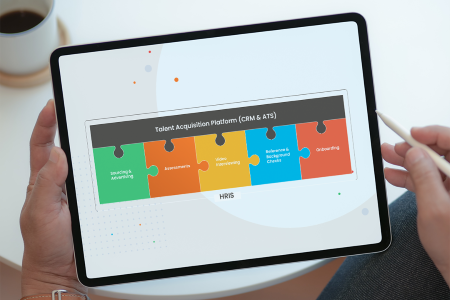
Introducing LiveHire’s New Chief Product and Technology Officer: A Q&A on Innovation, AI, and the Future of Talent Management
Why LiveHire?
At Arrived we knew that LiveHire was already doing something in the market that we originally aspired to do ourselves. Our goal was to connect exceptional individuals with meaningful work through our digital staffing platform. We understood the power of a platform to simplify the acquisition process and create an empowering and engaging experience for candidates. LiveHire shares a similar mission, but on a much larger scale, and had already proven themselves in the market. We immediately recognized that their platform was perfectly aligned with both our vision and our aspirations.
When we met the LiveHire Executive team, we recognized a great culture fit. LiveHire demonstrated a strong alignment in the way they fostered their internal culture and served their customers. We were truly inspired by this synergy and knew LiveHire would be a great home for our employees.
Finally, we understood the technical fit of the product. While it wasn’t our initial focus, we discovered that solving the complex problem of shift scheduling was a valuable competency and one that LiveHire highly valued. This further solidified the compatibility between our businesses.
As you come into your new role, what do you plan to focus on first?
I believe my most significant contribution to LiveHire will be helping us envision the future of this platform. We have successfully navigated the initial stages of the startup and scale-up journey, and have established ourselves in the market with a mature product. We have learned how to meet and exceed customers’ expectations. Now we are at a stage where continued growth requires expansion into new markets and even new business models.
Also, because we have such a solid technical foundation, we can now plan for innovations that will allow the platform to be the foundation for re-imagining talent acquisition.
We are at an inflection point that every successful SaaS platform encounters, where we have the opportunity to expand our reach to multiple diverse markets. To achieve this, we need to embrace new thinking and new processes. I will be focused on expanding our global presence, streamlining our teams and methodologies to be even more responsive to our customers, and aligning our future priorities to where we believe this market will be in the next few years.
Can you share your experience leading innovative product and technology teams at Microsoft?
During my tenure as a CTO at Microsoft, I had the opportunity to lead several innovation teams focused on discovering the applicability of leading edge technologies to real-world problems. These teams were small and for the most part, future-focused. Having said that, all of my technical teams were doing innovation work insofar as they were finding creative solutions for our customers while simultaneously innovating the ways in which they delivered value to our markets.
What does innovation mean to you?
Great question! In a technical field, most people think that the term innovation refers to the extent to which a specific technology is innovative. In other words, the extent to which it is an actual invention. Certainly, technologies in the AI, quantum computing, and web 3.0 spaces are incredibly innovative.
However, I believe that innovation which creates the most enduring value is the result of technology being creatively applied to complex or intractable problems. These problems are almost never technical in nature. Rather they are human problems. Think affordable and accessible healthcare, or climate solutions, or making internet connectivity possible for rural communities. The highly creative act of addressing these problems is the actual innovation. In fairness, solutions to these problems often require innovative technologies but it isn’t the technology itself that is most important. Rather it is how that technology is applied that is the measure of innovation.
What methodologies and strategies have you implemented to foster innovation and drive successful outcomes?
Innovation is inherently a creative process, so the priority for anyone building or managing an innovation team is to create an environment that fosters creativity. This is crucial because innovation is not about deductive reasoning aimed at reaching a single answer; it is an inferential process where the answer is unknown. This distinction leads to different processes around discovery, and fast development of small solutions that can be tested quickly and iterated upon as needs change.
The value of any innovation is directly linked to an understanding of the problem. To foster this, innovation teams often function better with members from diverse disciplines and backgrounds. Or, when the team is able to work in a cross-functional manner. I’m also a big fan of direct research and customer interaction. Top-down analysis of markets is helpful, but nothing compares to a first-person perspective of the problem to be solved.
What is your approach to staying on top of emerging technologies, particularly in the AI space?
Learning is a fundamental discipline that is essential for keeping up with technology. Continuous learning requires discipline. Mastering technical concepts can be daunting and I often think of the quote, “People often overestimate what they can accomplish in one year and underestimate what they can achieve in ten years.”
Figuring out what to learn is also important. You are effectively designing your own curriculum.I think in terms of adjacencies. For AI, adjacent skills include data management and analysis, statistics, and human learning models. Also, ethical issues in AI, privacy, governance, etc.
Do you envision incorporating these technologies (AI) into the LiveHire product roadmap and technology stack?
Absolutely! We are actively researching and planning various applications of AI to drive better efficiences in the recruiting process, and enhance candidate and employee engagement. There is great potential to disrupt many of existing processes within the pipeline of managing talent.
How do you separate hype from genuine innovation?
Ultimately, it all boils down to outcomes. Interestingly, hype, despite its negative connotations, serves a vital purpose. It fuels awareness, energy and investment in new areas. When people begin discussing the next big thing, it generates awareness, interest, and curiosity. In our interconnected world, interesting ideas often go viral and a lot can be learned from the conversations that ensue.
However, when it comes to true innovation, its success is measured by whether it actually achieves a desired outcome. We must evaluate whether it effectively addresses the problem we sought to solve and whether our intended approach proved successful.
What do you think is just over the horizon for LiveHire?
I believe we have a disruptive opportunity in the talent space. The LiveHire platform is designed to create great levels of engagement throughout the talent management process. We are unique in our ability to help recruiters drive productivity throughout their day and also provide an engaging experience for candidates. That gives us a robust foundation upon which we can address the next set of “Future of Work” issues that we see in the market.
The nature of work is changing faster than many employers can keep up with. As jobs change, their titles change, and the list of skills required to do them. Most jobs are becoming more digital. Technical roles require an ever-evolving understanding of specific technologies. Often, candidates describe their skills in non-standard ways, making it difficult to match them to openings.
Broader demographic issues in the labor market also contribute to shortages for certain roles. While we believe there is always untapped potential in the workforce, high potential candidates often remain elusive for lack of a common taxonomy to assess and measure the applicability of skills and experiences to new job types.
Technology platforms like LiveHire are uniquely positioned to use AI and other modern technologies to see through the noise in the market and match the right candidates to the right opportunities.
Just as importantly, LiveHire has the potential to democratize access to work for people across all demographics and at every level of the wage scale. In an age of accelerated digital adoption, employers need to hire for potential as much as for proven abilities. The compute power of a platform is required to quickly reason over hundreds or thousands of candidates and find the right opportunities for them.
I see a future where LiveHire not only finds and engages candidates, but also nurtures and develops them by providing insights into learning paths aligned to a candidate’s desired roles.
What do you see for the future of Direct Sourcing, how is technology impacting this space and do you have any thoughts on what’s ahead?
At its core, direct sourcing aims to foster stronger connections between employers and a significant yet often overlooked segment of their workforce, contingent employees. This aspiration to establish closer ties is the driving force behind direct sourcing. Moreover, there is sound business model logic supporting this approach. By forging direct connections, the process eliminates much of the intermediary infrastructure, streamlines workflows, and facilitates faster, more efficient connections. This, in turn, offers cost advantages to employers.
Large companies that are leading the charge on direct sourcing initiatives are writing the playbook on how to implement change management strategies required for broad-scale adoption. Additionally, Managed Service Providers (MSPs), Recruitment Process Outsourcing (RPO) providers and other constituents in this space are also adapting and fine-tuning the model. It’s an exciting time for us to be the technology platform powering that change.
The likely evolution of Direct Sourcing is that it will become a cohesive part of a broader talent management solution where organizations big and small are able to effective find, engage, recruit and nurture their future talent regardless of the classification of those individuals: full-time, part-time, temporary, gig, or contractor. This is our highest aspiration, to truly enable the flow of all of the world’s talent.





